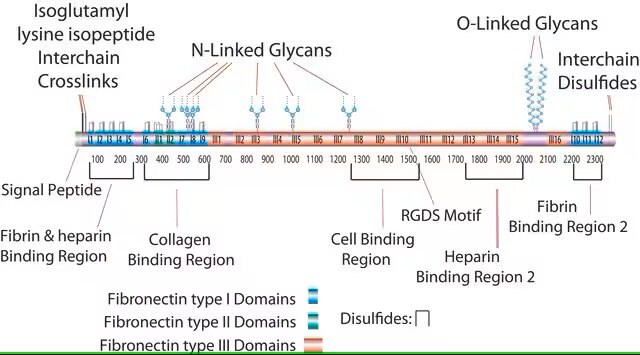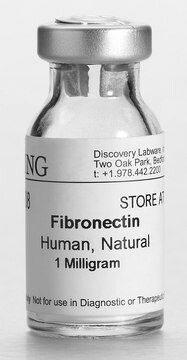FG001
Fibronectin/Gelatin Coating Solution
0.2 μm filtered, BioReagent, suitable for cell culture, Ready-to-use mixture
Sign Into View Organizational & Contract Pricing
All Photos(1)
About This Item
UNSPSC Code:
12352202
NACRES:
NA.71
Recommended Products
Quality Level
sterility
0.2 μm filtered
product line
BioReagent
concentration
1 ×
technique(s)
cell culture | mammalian: suitable
shipped in
dry ice
storage temp.
-10 to -25°C
General description
Fibronectin/Gelatin Coating Solution is a ready-to-use attachment factors mix solution, that is 0.2 µm filtered. It is used to coat cell culture flasks, dishes, and multi-well plates and used to promote the attachment, spreading and proliferation of variety of cell types, especially Endothelial Cells, HL-1 Cardiac Muscle Cell Line (SCC065) and cells that require ECM-coated surface for adhesion and 2D cell-culture growth. Fibronectin/Gelatin Coating Solution prevents endothelial cell monolayer from peeling under shear stress. Fibronectin/Gelatin Coating Solution mix is suitable for use with serum-free or reduced -serum cultures.
Application
Fibronectin/Gelatin Coating Solution can be used in:
- Attachment and spreading of a variety of cell types
- Suitable for use with serum-free or reduced -serum cultures
Biochem/physiol Actions
Fibronectin is involved in widespread interactions and functions, such as the attachment and migration of many cell types, cytoskeletal assembly, tyrosine phosphorylation, and metastasis. Fibronectin is produced by a wide variety of epithelial and mesenchymal cells in vitro including fibroblasts, chondrocytes, myoblasts, Schwann cells, macrophages, hepatocytes, and intestinal epithelial cells.
Gelatin derived proteins are extracted by boiling the relevant skin, tendons, ligaments, bones, etc. in water. Gelatin is a hydrocolloid and is rich in glycine, proline and hydroxyproline, which imparts structural stability.
Gelatin derived proteins are extracted by boiling the relevant skin, tendons, ligaments, bones, etc. in water. Gelatin is a hydrocolloid and is rich in glycine, proline and hydroxyproline, which imparts structural stability.
Components
Fibronectin is a multifunctional, extracellular matrix adhesion glycoprotein that is used as a substrate to promote attachment of cells. Multiple domains of fibronectin show binding affinities for collagen, fibrin, heparin, and specific cell membrane receptors.The most notable domain, Arg-Gly-Asp (RGD), is recognized by integrins and mediates cell adhesion.
Gelatin is a heterogeneous mixture of water-soluble proteins, present in collagen and an ideal cell-attachment substrate for cell culture.
Gelatin is a heterogeneous mixture of water-soluble proteins, present in collagen and an ideal cell-attachment substrate for cell culture.
Preparation Note
FG001 is a ready-to-use mixture composed of Fibronectin and Gelatin. It is filtered using 0.2µm filter. Gently mix the Fibronectin/Gelatin Coating Solution a few times to form a homogenous solution before use. For use as a coating solution, cover the entire culture surface area, approximately 0.2-0.25 mL/cm2. Incubate at room temperature for 2-3 hours and carefully aspirate the solution and wash 3 times with sterile PBS before plating the cells.
The coated tissue culture vessels can be used immediately or stored at 4 °C for up to one week filled with PBS and wrapped in parafilm. Remove PBS only when ready to plate the cells. Do not let the coated plates dry completely.
The coated tissue culture vessels can be used immediately or stored at 4 °C for up to one week filled with PBS and wrapped in parafilm. Remove PBS only when ready to plate the cells. Do not let the coated plates dry completely.
Storage Class Code
12 - Non Combustible Liquids
WGK
WGK 1
Choose from one of the most recent versions:
Certificates of Analysis (COA)
Lot/Batch Number
It looks like we've run into a problem, but you can still download Certificates of Analysis from our Documents section.
If you need assistance, please contact Customer Support.
Already Own This Product?
Find documentation for the products that you have recently purchased in the Document Library.
Our team of scientists has experience in all areas of research including Life Science, Material Science, Chemical Synthesis, Chromatography, Analytical and many others.
Contact Technical Service




